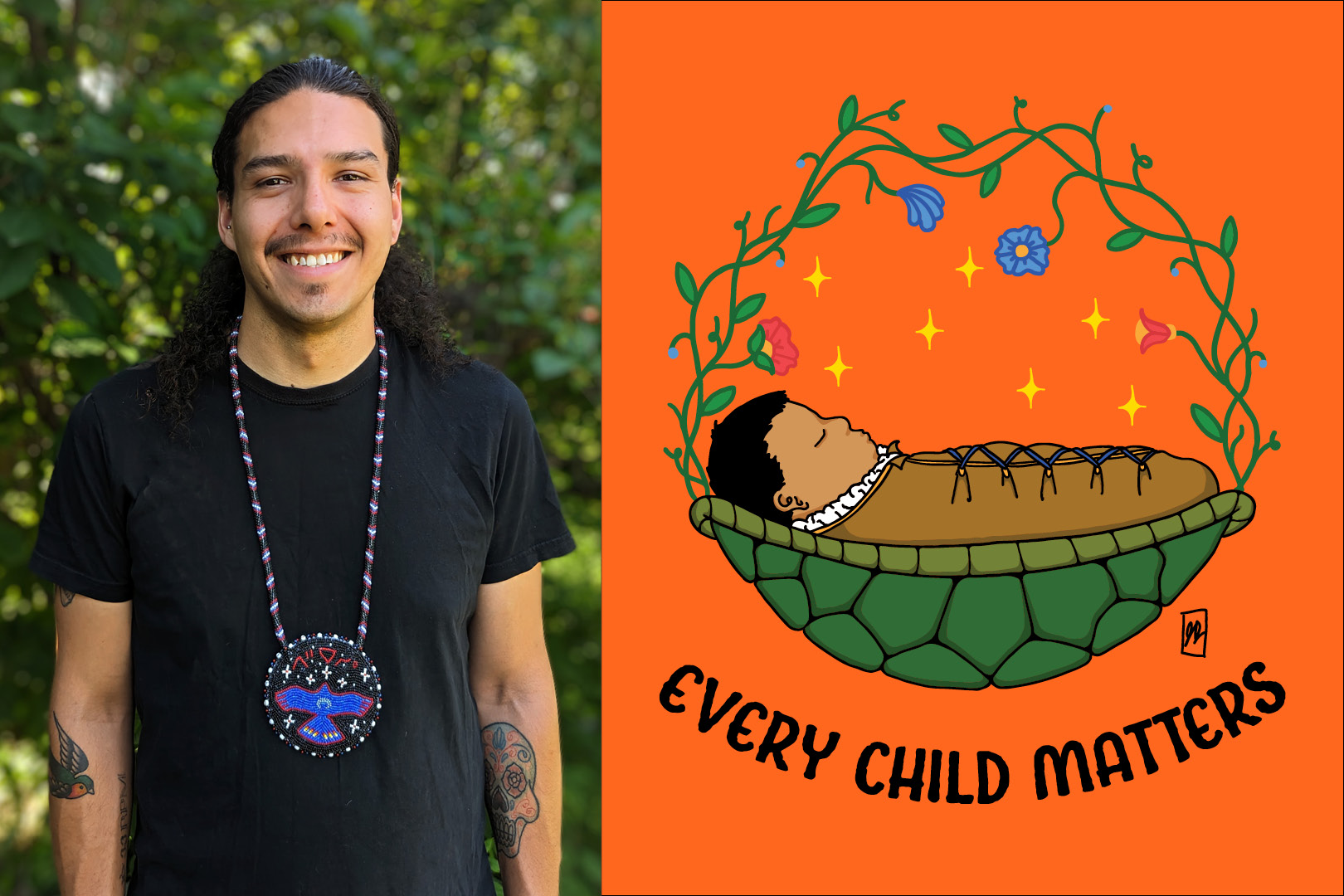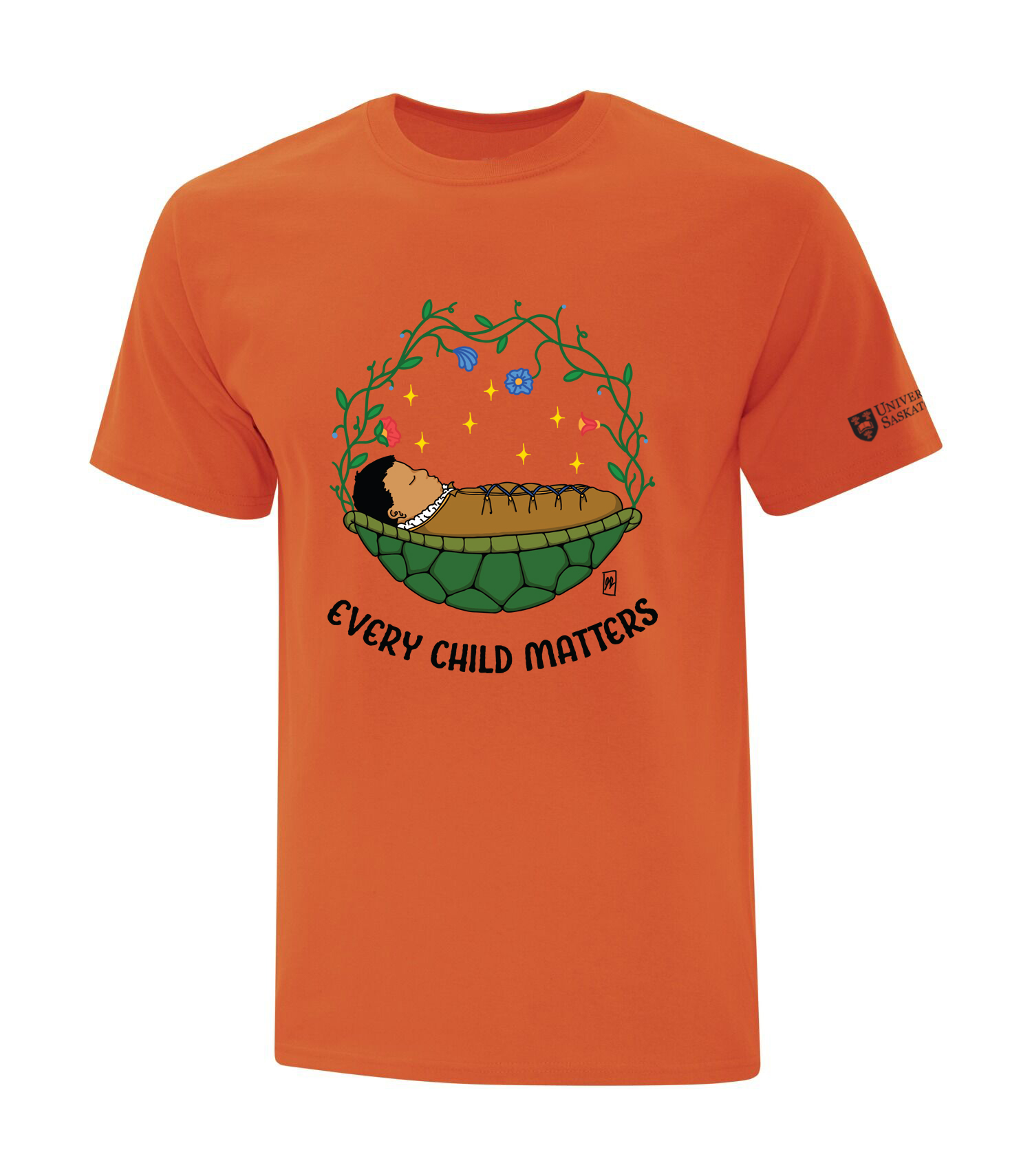
Saskatoon artist creates “Turtle’s Protection” to help the USask community acknowledge Orange Shirt Day 2024
Orders are open at the University of Saskatchewan for orange shirts featuring a commissioned design by James Desjarlais
In 2019, the University of Saskatchewan (USask) Indigenous Space and Visual Symbols in the Health Sciences Committee began working with Shop USask to coordinate the sale of non-college-specific orange shirts to help the campus community recognize Orange Shirt Day on Sept. 30.
To date, orange shirt proceeds totalling over $35,000 have been directed toward a fund supporting the implementation of the Truth and Reconciliation Commission’s Calls to Action with a portion of proceeds also being directed toward the artist.
This year, shirts featuring “Turtle’s Protection” by Cree/Saulteaux artist James Desjarlais will be available through Shop USask beginning Monday, July 15.
We asked James about his journey as an artist and why it was important to help create a piece for the USask community to acknowledge Orange Shirt Day.
When did you begin your journey as an artist and how did you get to where you are now?
My journey as an artist began when my heart first started beating within my mother’s womb. I have always felt the call to express myself through art. One of my earliest memories is decorating the walls of my toddler room with whatever I was able to find — much to my parent’s dismay. Growing up, I would doodle in the margins of my homework, on my desk, and any space that wasn’t being used. I have always been comfortable sketching in pen or pencil, preferring to work in black and white, although I do find it rewarding to challenge myself to add colour. As an emerging artist, I prefer to work digitally as I can create without waste and without limit to a global audience from the space of my own home.
My previous work includes designing album cover art for Gabriel Dumont Local 11 (GD Local 11), a mural for DTNYXE’s alley gallery in downtown Saskatoon, and multiple clothing designs for Decolonial Clothing Company.
What influences your work?
Every art piece I create is drawn from the lessons and teachings that have been passed down to me. I have been greatly inspired by my personal history with the residential school system and the damage systemic racism has caused. With art, I believe that I can create meaningful and lasting change in Saskatoon, in Canada, and in the world at large.
How do you work? What is your process?
Before I put pen or stylus down on paper, I start with an idea or a vision. Inspiration can take many forms; as an artist I must allow myself to be open to these ideas and visions as they come, regardless of where I am or what I’m doing. Once an idea, theme or vision has taken root, I begin to visually plan how the piece will look. This can look like rough sketches on multiple pieces of paper, mental notes in my head, or even pictures of places, people, and things that may catch my eye or my phone’s camera lens.
What themes do you pursue?
As a contemporary artist with a traditional Indigenous upbringing, there are many themes that speak to me, especially concerning the dual nature of my personal background. I have lived a life that can be separated into two worlds, and I find that the themes and views of one often collide violently with themes and views of the other. I understand that as people we are multifaceted and complex underneath the surface. Our existence is a collection of many traditions and beliefs that have been inherited willingly and unwillingly. This theme of who we are — our differences and similarities, how underneath we all have a story — is what motivates me to express myself through art.
What is your dream project?
I grew up reading Marvel comics about superheroes doing the right thing, which I credit as my biggest influence and first push to become an artist. I would love to create a graphic novel dealing with colonization, traditional lifestyles, and Indigenous ways of knowing. Alternatively, creating and working for Marvel to bring more Indigenous representation to the superhero and comic book community is a lifelong dream of mine.
What would you like people to know about the piece you created to help the USask community acknowledge Orange Shirt Day?
This digitally created piece called “Turtle’s Protection” is circular in shape, much like Mother Earth and the Medicine Wheel. Cradled inside of a turtle shell, a baby lies sleeping — blanketed and protected by Mother Earth’s flora.
The turtle shell and moss bag represent the protection, love, security, and truth that our children need today. Above is Mother Earth, arching over the child and the shell; her nature is the final barrier of protection that each precious child deserves.
Seven small and simple stars float above the child and within the circle. The stars are representative of seven generations of descendants. This concept is important to the continued survival of the nehiyaw, as leaders and chiefs would need to think about the effects and consequences of their actions seven generations ahead.
Why was it important for you to create this piece?
Personally, I have felt the intergenerational trauma from residential schools and systemic racism and have grown up in an environment where these challenges were present in the homes of myself, my friends, and my peers. There is constant pushback and struggle when serving justice in any unjust situation and the first step starts with spreading the truth. The truth about residential schools is challenged time and time again in Canada and it is important to never forget our history.

Proceeds from the sales of shirts featuring James’ artwork will be directed toward a fund supporting the implementation of the Truth and Reconciliation Commission’s Calls to Action with a portion of proceeds also being directed toward the artist.
To order an orange shirt from Shop USask, visit https://shop.usask.ca/orange-shirt-day
- Group/department orders of 20 or more are eligible to receive a 10% discount and should be placed no later than Aug. 30 to ensure arrival by Sept. 23.
To learn more about Orange Shirt Day, the Canadian residential school system and other important topics, please visit the links below:
- Learn about Indigenization, decolonization, Indigenous wellness resources, and the history of Indigenous Peoples and cultures through the Office of the Vice-Provost Indigenous Engagement (OVPIE) websiteand the University Library’s I-Portal: Indigenous Studies Portal.
- USask Spotlight webpage for the National Day for Truth and Reconciliation
- A research guide created by Métis librarian Sheila Laroque offers a wide variety of resources and invites us to continue our collective learning journey.
- OrangeShirtDay.org
- Reconciliation Saskatchewan
- Saskatoon Tribal Council
- Every Child Matters: Truth – Act One and Every Child Matters: Reconciliation – Act Two (via The National Centre for Truth and Reconciliation)
- History of Residential Schools in Canada (via Canadian Geographic Indigenous Peoples Atlas of Canada)
- ‘Cultural genocide’: the shameful history of Canada’s residential schools – mapped (via The Guardian)
- Residential Schools in Canada: A Timeline (video via Historic Canada)
- Stolen Children | Residential School survivors speak out (video via CBC News: The National)
- Truth and Reconciliation Commission of Canada (Government of Canada)
For emotional crisis referral services and information on other health supports from the Government of Canada, residential school survivors can call 1-866-925-4419.
The University of Saskatchewan community is encouraged to access support services through Student Affairs and Outreach by calling (306) 966-5757 or emailing intake@usask.ca.
The Hope for Wellness Help Line is also available to Indigenous peoples across Canada 24 hours a day, 7 days a week for counselling and crisis intervention. Toll-free at 1-855-242-3310 or available via online chat at hopeforwellness.ca.
Together, we will work towards Truth and Reconciliation. We invite you to join by supporting Indigenous achievement at USask.
Article re-posted on .
View original article.

